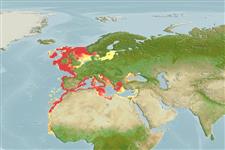Preferred temperature (ссылка
123201): 6.9 - 15, mean 10.7 °C (based on 295 cells).
Phylogenetic diversity index (ссылка
82804): PD
50 = 1.5000 [Uniqueness, from 0.5 = low to 2.0 = high].
Bayesian length-weight: a=0.01905 (0.01469 - 0.02472), b=2.82 (2.74 - 2.90), in cm total length, based on LWR estimates for this species (Ref.
93245).
Trophic level (ссылка
69278): 3.1 ±0.3 se; based on diet studies.
устойчивость к внешним воздействиям (ссылка
120179): низкий, минимальное время удвоения популяции 4.5-14 лет (K=0.145; tmax=26; tm=1.84).
Prior r = 0.44, 95% CL = 0.29 - 0.67, Based on 1 full stock assessment.
Fishing Vulnerability (Ref.
59153): Low vulnerability (20 of 100).
🛈
Climate Vulnerability (Ref.
125649): Low vulnerability (19 of 100).
🛈
Nutrients (Ref.
124155): Calcium = 74.7 [37.7, 139.1] mg/100g; Iron = 1.11 [0.56, 2.07] mg/100g; Protein = 17.9 [16.7, 19.0] %; Omega3 = 0.313 [0.180, 0.549] g/100g; Selenium = 37 [16, 86] μg/100g; VitaminA = 18.1 [4.5, 77.6] μg/100g; Zinc = 0.767 [0.502, 1.164] mg/100g (wet weight);
